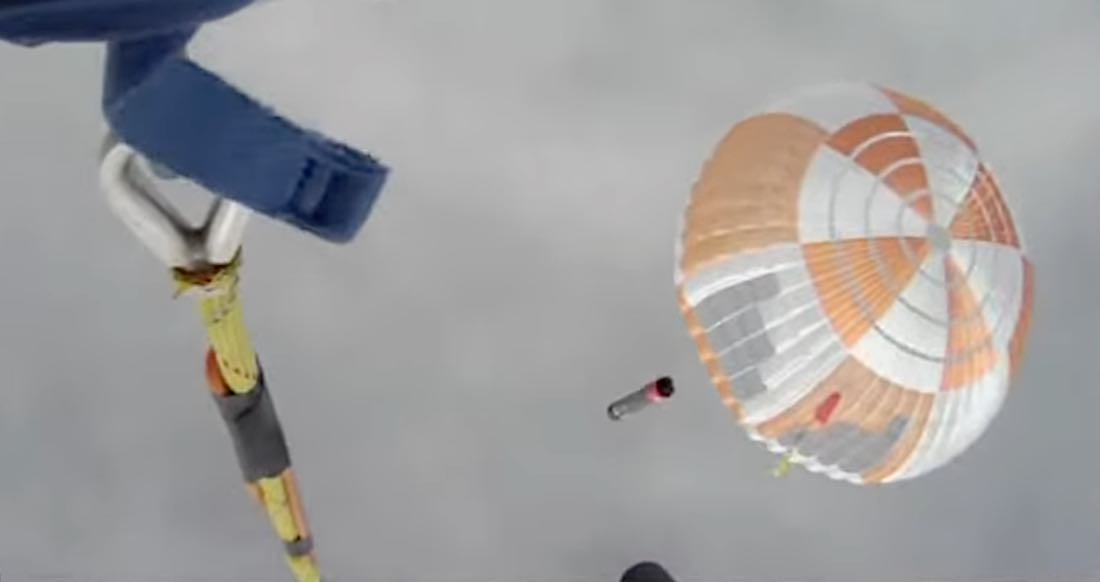
Rocket Lab will try again Friday to catch an Electron first stage booster after launching from New Zealand with a small Swedish science satellite, six months after the company’s first mid-air recovery attempt.
The launch window for the Electron rocket Friday opens at 1:15 p.m. EDT and extends until 2:30 p.m. EDT (1715-1830 GMT). The mission will be the ninth Rocket Lab launch of the year, and the 32nd flight of an Electron rocket overall.
Rocket Lab wants to recover and reuse the first stage of the Electron rocket, a small satellite launcher that stands about 59 feet (18 meters) tall. The booster stage, which measure about 39 feet (12 meters) long, does not have enough reserve fuel to perform a propulsive landing like SpaceX’s Falcon 9 rocket, so Rocket Lab devised a recovery method using a parachute and a helicopter to capture the Electron first stage in mid-air.
Engineers completed several experiments to test the Electron booster’s heat shield and parachute system. On those missions, Rocket Lab retrieved the booster from the Pacific Ocean downrange from the launch site in New Zealand.
Rocket Lab added the recovery helicopter to the mix on a May 2 launch. A customized Sikorsky S-92 helicopter fitted with a long boom snared the booster as it descended under parachute, but the helicopter pilot commanded release of the rocket after sensing “different load characteristics” than experienced during previous tests, Rocket Lab said.
After additional training and rehearsals, Rocket Lab is ready to try again with the helicopter.
“Our first helicopter catch only a few months ago proved we can do what we set out to do with Electron, and we’re eager to get the helicopter back out there and advance our rocket reusability even further by bringing back a dry stage for the first time,” said Peter Beck, Rocket Lab’s founder and CEO, in a press release.
The Sikorsky S-92 helicopter will attempt to capture the rocket by its parachute about 180 miles (290 kilometers) off the coast of New Zealand. Rocket Lab has nicknamed the upcoming mission “Catch Me If You Can.”
Catching the booster in mid-air prevents it from reaching the ocean, eliminating the risk of hardware corrosion or damage from splashdown in salt water, and easing refurbishment work required to make the rocket suitable to launch again.
The Electron booster is powered by nine kerosene-fueled Rutherford engines. The rocket also has a single-engine second stage, and a third stage capable of placing small payloads into orbit.

Despite the problem securing the booster with the helicopter during the May 2 mission, Rocket Lab recovered the rocket from the sea brought it back to shore. The company announced Sept. 1 that it completed a full-duration, full-thrust test-firing of a refurbished engine from the booster recovered in May. The engine passed all of the “rigorous acceptance tests” Rocket Lab performs for every engine, including 200 seconds of burn time and multiple restarts, the company said.
The refurbished engine “performed to the same standard of a newly-built Rutherford engine,” Rocket Lab said. The company doesn’t plan to fly the engine again, but will it will be a “life-leader” to support future Rutherford engine development.
A successful mid-air recovery would be a big step forward for Rocket Lab’s aim to refurbish and reuse an entire Electron booster.
The mission will haul Sweden’s Mesospheric Airglow/Aerosol Tomography and Spectroscopy, or MATS, satellite into polar orbit after liftoff from Rocket Lab’s privately-owned spaceport on Mahia Peninsula, located on the North Island of New Zealand.
The first stage of the Electron will shut off its nine Rutherford engines about two-and-a-half minutes after launch, then separate from the second stage to begin its descent back into the atmosphere.
The booster will reach a top speed of 5,150 mph (8,300 kilometers per hour). Aerodynamic drag will slow the rocket’s velocity as external temperatures build up to 4,350 degrees Fahrenheit (2,400 degrees Celsius).
Then a drogue chute and main chute will deploy to slow the booster’s descent to about 22.3 mph (10 meters per second). The recovery helicopter will move in from above the rocket to capture the rocket ‘s parachute line with a hook on the end of a long boom. Rocket Lab will bring the rocket back to its production facility in Auckland for inspections to assess its suitability for reuse, the company said.
Aside from reusing the Electron boosters themselves, Rocket Lab plans to apply lessons to its next-generation Neutron rocket, which has a booster that will perform propulsive landings like SpaceX’s Falcon 9.
While the booster comes back to Earth, the upper stage of the Electron rocket will continue firing into orbit with the 119-pound (54-kilogram) MATS satellite. Rocket Lab’s kick stage, or third stage, will finish the task of injecting the payload into a circular 363-mile-high (585-kilometer) polar orbit. The spacecraft will separate from the kick stage about one hour into the mission.

The MATS satellite is funded by the Swedish National Space Agency, and is designed to study waves in Earth’s atmosphere.
“We hope that MATS will give us a better understanding of how angular momentum and energy are transported between different parts of the atmosphere. This is an area with large knowledge gaps that MATS will help us fill,” said Linda Megner, a researcher at Stockholm University’s department of meteorology.
The satellite was built by OHB Sweden, and carries an instrument to image variation in light emitted by oxygen molecules in the upper atmosphere, as well as noctilucent clouds that form about 50 miles (80 kilometers) above Earth’s surface.
The MATS satellite was originally assigned to launch as a rideshare payload on a Russian Soyuz rocket, but Swedish officials moved the mission to a dedicated launch on a Rocket Lab mission after Russia’s invasion of Ukraine earlier this year.
Email the author.
Follow Stephen Clark on Twitter: @StephenClark1.
